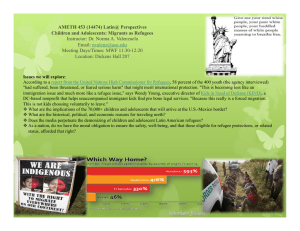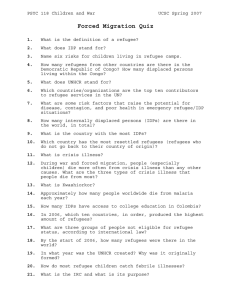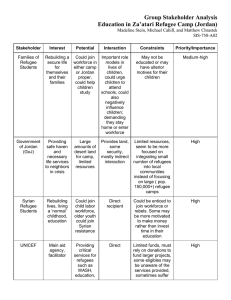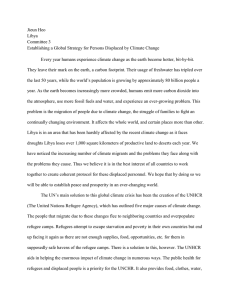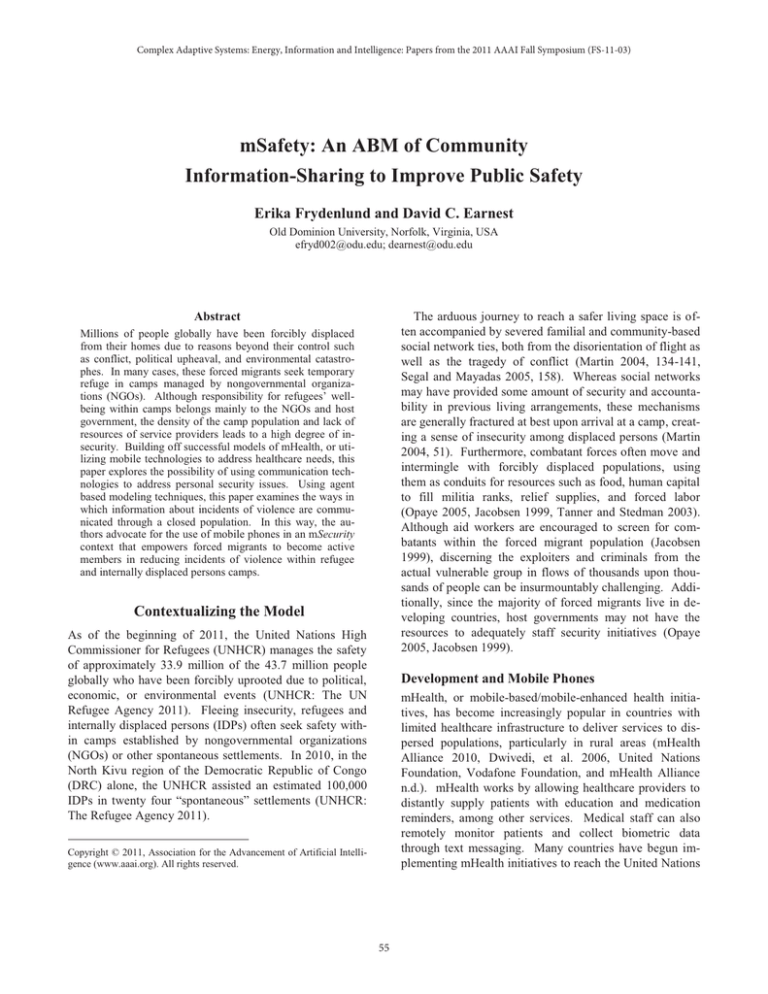
Complex Adaptive Systems: Energy, Information and Intelligence: Papers from the 2011 AAAI Fall Symposium (FS-11-03)
mSafety: An ABM of Community
Information-Sharing to Improve Public Safety
Erika Frydenlund and David C. Earnest
Old Dominion University, Norfolk, Virginia, USA
efryd002@odu.edu; dearnest@odu.edu
The arduous journey to reach a safer living space is often accompanied by severed familial and community-based
social network ties, both from the disorientation of flight as
well as the tragedy of conflict (Martin 2004, 134-141,
Segal and Mayadas 2005, 158). Whereas social networks
may have provided some amount of security and accountability in previous living arrangements, these mechanisms
are generally fractured at best upon arrival at a camp, creating a sense of insecurity among displaced persons (Martin
2004, 51). Furthermore, combatant forces often move and
intermingle with forcibly displaced populations, using
them as conduits for resources such as food, human capital
to fill militia ranks, relief supplies, and forced labor
(Opaye 2005, Jacobsen 1999, Tanner and Stedman 2003).
Although aid workers are encouraged to screen for combatants within the forced migrant population (Jacobsen
1999), discerning the exploiters and criminals from the
actual vulnerable group in flows of thousands upon thousands of people can be insurmountably challenging. Additionally, since the majority of forced migrants live in developing countries, host governments may not have the
resources to adequately staff security initiatives (Opaye
2005, Jacobsen 1999).
Abstract
Millions of people globally have been forcibly displaced
from their homes due to reasons beyond their control such
as conflict, political upheaval, and environmental catastrophes. In many cases, these forced migrants seek temporary
refuge in camps managed by nongovernmental organizations (NGOs). Although responsibility for refugees’ wellbeing within camps belongs mainly to the NGOs and host
government, the density of the camp population and lack of
resources of service providers leads to a high degree of insecurity. Building off successful models of mHealth, or utilizing mobile technologies to address healthcare needs, this
paper explores the possibility of using communication technologies to address personal security issues. Using agent
based modeling techniques, this paper examines the ways in
which information about incidents of violence are communicated through a closed population. In this way, the authors advocate for the use of mobile phones in an mSecurity
context that empowers forced migrants to become active
members in reducing incidents of violence within refugee
and internally displaced persons camps.
Contextualizing the Model
As of the beginning of 2011, the United Nations High
Commissioner for Refugees (UNHCR) manages the safety
of approximately 33.9 million of the 43.7 million people
globally who have been forcibly uprooted due to political,
economic, or environmental events (UNHCR: The UN
Refugee Agency 2011). Fleeing insecurity, refugees and
internally displaced persons (IDPs) often seek safety within camps established by nongovernmental organizations
(NGOs) or other spontaneous settlements. In 2010, in the
North Kivu region of the Democratic Republic of Congo
(DRC) alone, the UNHCR assisted an estimated 100,000
IDPs in twenty four “spontaneous” settlements (UNHCR:
The Refugee Agency 2011).
Development and Mobile Phones
mHealth, or mobile-based/mobile-enhanced health initiatives, has become increasingly popular in countries with
limited healthcare infrastructure to deliver services to dispersed populations, particularly in rural areas (mHealth
Alliance 2010, Dwivedi, et al. 2006, United Nations
Foundation, Vodafone Foundation, and mHealth Alliance
n.d.). mHealth works by allowing healthcare providers to
distantly supply patients with education and medication
reminders, among other services. Medical staff can also
remotely monitor patients and collect biometric data
through text messaging. Many countries have begun implementing mHealth initiatives to reach the United Nations
Copyright © 2011, Association for the Advancement of Artificial Intelligence (www.aaai.org). All rights reserved.
55
Mobile Phone Subscriptions
# Phones Per 100 People
120
World
100
Bangladesh
80
Ecuador
60
Pakistan
40
Venezuela, RB
20
1990
1991
1992
1993
1994
1995
1996
1997
1998
1999
2000
2001
2002
2003
2004
2005
2006
2007
2008
2009
2010
Congo, Dem. Rep.
0
Figure 1: Mobile Phone Subscriptions in Top 5 Countries Hosting Refugees
Practically speaking, mobile phone access within refugee and IDP camps may not always be an option, but if
available, this technology may be capable of fostering, to
some degree, networks to report acts of violence (Barrow
2006). The UNHCR and World Food Program have been
utilizing text SMS messages through mobile phones to
alert urban refugees to food distribution sites since 2007
(Pagonis 2007). Estimating that 78 percent of refugees and
IDPs in East Africa have access to mobile technologies, a
Denmark-based NGO began a collaborative campaign to
help forced migrants in Uganda reconnect with lost family
members through services available from their mobile
phones (Refugees United 2011). Among other uses of
technology to improve the lives of refugees, the UNHCR is
experimenting with capabilities that would allow processing of forced migrants to be done via mobile phones.
This data would be stored in a cloud, facilitating faster
reunification of separated family members and centralized
data storage for more efficient processing (Malik 2011).
Generally, information dissemination within camp situations occurs predominantly among a select group of refugees somehow determined to be leaders. Whether or not
the information actually gets passed along is entirely dependent on the choices of these select few (UNHCR: The
UN Refugee Agency 2006). Given the current trends in
mobile phone use in the context of the developing world, it
is reasonable then to suggest the use of mobile technologies to meet informational needs of a wider population of
refugees. When physical security is under-sourced, communities may be able to increase their collective safety
through the use of low-cost technologies like mobile
phones by monitoring and sharing information about violent incidents. As mentioned above, many refugees al-
Millennium Development goals, such as reducing maternal
and infant mortality and providing wider access to
healthcare (Rasmussen 2010).
Inspired by the success of mHealth technology and the
increasing accessibility of mobile phones in developing
countries, the authors of this paper questioned whether
mobile phones could be utilized to increase security as well
as health. During a visit to Kiziba refugee camp in the
Lake Kivu region of Rwanda earlier this year, one of the
authors noted the widespread use of pay-per-use mobile
phones. Despite the lack of access to electricity within this
camp, mobile phones could be recharged at small shops
equipped with solar power.
Mobile phones in many developing countries, particularly in Africa, have become less of a luxury and more of a
necessity. Bangladesh, Ecuador, Pakistan, and Venezuela
together host 92% of the estimated 1.6 million people living in refugee-like situations (UNHCR: The UN Refugee
Agency 2011). Figure 1 depicts mobile phone subscriptions in each of these countries and includes the DRC due
to its relevancy in the current study (International
Telecommunication
Union,
World
Telecommunication/ICT Development Report and
database, and World Bank estimates. 2009). Although
Pakistan, Bangladesh, and the DRC lag behind average
global levels of mobile phone access, number of subscribers in all cases has gone up precipitously since around
2005. This increase in mobile phone access, even in countries burdened by development issues, indicates the feasibility of utilizing this technology to reach certain development goals, such as providing security for displaced populations.
56
ready possess mobile phones and infrastructure is generally
in place to make use of them even in the context of forced
displacement. Implementing a plan to utilize this existing
structure would be relatively low-cost for the camp funding
organizations.
It is important to note here that the concept for this model is not based on the expectation that users report into
some central database that will dispatch security as needed
to certain areas, though if resources permit, that would also
be helpful in improving security. The idea here is that, like
with mHealth, mobile phones allow for individuals to take
control and become part of the solution to the problem.
Rather than sharing important first-hand knowledge about
incidents of violence only with a close set of friends and
family, mobile phones might provide a way for districtsized areas within a camp to monitor their own security
threats. Through mobile phone technology, agents become
active participants in naming and shaming criminals as
well as developing a larger picture of where danger
hotspots exist and how best to avoid them. This type of
community-based approach to solving problems is in fact
outlined in the UNHCR operational security handbook as
essential to developing strategies that are effective and
durable (UNHCR: The UN Refugee Agency 2006, 14, 17).
As in the case of mHealth, service providers could also
utilize this data to prioritize service to the portions of the
population most in need of assistance. In the context of
refugee camps, the successful implementation of an mSafety strategy would allow limited security staff to better position themselves to ensure high levels of safety among the
refugees and IDPs.
Figure 2: Map of DRC and Mugunga III
(UNHCR & UNOPS 2010)
ple, it is currently the home to approximately 4,625 individuals in 1,210 homes (UNHCR & UNOPS 2010).
Recent outbreaks of violence, in particular attacks on
humanitarian aid workers in the DRC, have reduced many
NGOs’ capacity for providing safety and aid for vulnerable
populations (Mubalama 2011). IDPs within the Mugunga
III camp have become particularly vulnerable to these violent outbreaks as security measures fall short of effective.
Women in Mugunga III, as with forcibly displaced women
more generally, become vulnerable to attacks while fetching necessary resources such as firewood. Men often refuse to accompany women to retrieve resources because
encounters with combatants mean certain death for them,
whereas women often escape after being beaten and raped
(Schmitt 2011).
Mugunga III
Though each forced migration situation is different, many
camps share common themes. Among the many camps
operating under the umbrella of UNHCR, Mugunga III
serves as an illustration of the kinds of insecurity endured
by refugees and IDPs.
Political and social unrest in the late 1990s led to the
forced displacement of well over one million people in the
Democratic Republic of Congo, among other countries in
the Great Lakes Region of Africa (Central Intelligence
Agency 2011). Despite a calming of the political climate
in the DRC which has allowed many IDPs to leave settlements and return home, violence continues to plague certain areas (UNHCR: The Refugee Agency 2011).
Mugunga III (see Figure 2) is an IDP temporary settlement in the North Kivu region of the DRC that houses the
most vulnerable of the populations remaining after the closure of camps Mugunga I and Mugunga II in 2008
(Redmond 2009, van Bruaene, Scheuermann and Lukmanji
2011, 30). Though it can accommodate up to 60,000 peo-
Developing the Model
The focus in this study is individual behaviors operating
heterogeneously and autonomously to produce macro-level
effects. Due to the interest in individuals harnessing the
power of mobile technologies to increase group security,
agent based modeling techniques were appropriate for this
particular research question. Agent-based models are a
valuable method for investigating research questions characterized by: autonomous agents who interact repeatedly
over time; nonlinear cause-effect relationships; a large
number of variables that exhibit interaction complexity;
difficulties with gathering empirical data; and a scarcity of
events (Lustick, Miodownik and Eidelson 2004). Arguably, all five conditions characterize the study of using mobile phone-based, crowd-sourced information about incidents of violence to increase personal security within forcibly displaced populations.
57
Figure 3: Map of Mugunga III used in the Model (UNHCR & UNOPS 2010)
Though there is great diversity of people within refugee
camps, the model restricts the scenario to three types of
agents: refugees, insurgents, and security forces. While
this limits the presence of other types of individuals, aid
and healthcare workers for instance, it sufficiently covers
all necessary actors to address security concerns. Since aid
workers have been the target of attacks as well, for simplicity, it can be assumed that their participation in security
is included within the set refugee agents. Like refugees,
they might travel around the camp between resource distribution sites. Just as refugees might communicate safety
issues to one another within the camp, it can be assumed
that aid workers would also benefit and participate in that
type of information exchange.
the model (see Figure 3). Agents navigate pathways that
reflect actual main walkways in this particular camp. Locations of facilities, such as latrines, housing structures,
and water sources were imported based on the actual layout of Mugunga III. These are depicted visually in the
model as small squares colored to reflect their respective
resource type (see Figure 3 and Figure 4). This particular
camp is just one example of a possible settlement configuration. As is expected from settlements that often spontaneously grow during moments of mass migration, it is impossible to create a camp that models a predominant layout. Mugunga III was chosen based on the availability of
detailed UNHCR maps and its documented accounts of
non-refugees instigating violence.
Simulated Camp World
Agent Intelligence
To help contextualize the situation of security in refugee
camps, a map of Mugunga III IDP camp was utilized for
Each of the three types of agents manages different decision criteria in order to achieve its goals. Visually, refu-
58
ical tolls as well as the loss of a resource that might be incurred if one is the victim of a violent act. If a refugee has
lost all of her resources, she then dies.
gees are depicted in the model as blue people-shaped
agents (see Figure 4). Refugees are given a randomized
list of destinations that they must reach in order to collect
resources and increase their well-being. The refugees navigate main pathways through the camp in order to get to
their intended destination. If the destination is successfully
reached, the refugee adds to his/her pool of resources.
Agents only veer off main walkways if they are going to
their house (generally in the spaces between the walkways)
or the security stations located in the open space to the
south of the camp.
Security forces, the final agent type, are represented visually in the model as flags. The presence of the forces at
distribution sites deters insurgents from stealing from refugees. Unfortunately, as mentioned above, security is often
under-resourced and is spread very thin over a vast, densely populated area. Though they are depicted by a single
agent in the model, these agents are interpreted to be travelling in groups large enough to deter minor security
threats. For simplicity, in this model security forces wander the main section of the camp attempting only to deter
crime.
Insurgents are allowed to roam off the walkway. This
feature is meant to reflect that these agents are not necessarily operating freely within the camp, but rather trying to
keep from being noticed by security forces. Rather than
approach a distribution site to collect a resource, they lurk
outside and wait for refugees to come. By “lurking,” we
mean here that an insurgent will hover around a resource
distribution site waiting for other refugees to come regardless of whether he has already stolen from someone. After
a certain period of time, the insurgent will move on to lurk
at a new resource site.
Agent Communication
In the model, an on/off switch controls whether agents
have access to communication technology analogous to
mobile phones. When there is no technological solution
for conveying sites and acts of violence, agents talk to
those with whom they come into close contact. After either being the victim of or witness to an act of violence at a
resource site as described above, refugees will tell others
who come within a very close distance, meant to represent
a conversational exchange about where the event occurred.
Eventually, emotions of the event fade and the refugee
“forgets” to tell others about the incident. The memory of
violence for refugees in this model is limited to only five
incidents, so he or she may continue to avoid a site of violence until it is forgotten and replaced by more recent information.
If the agents are able to use communication technology,
they are initialized to be part of a random sized network.
This is intended to reflect the fact that some refugees will
have a wider influence than others. If a refugee becomes
the victim of or witness to an act of violence, the site is
recorded in the agent’s memory and he instantly tells all of
the members of his network. These refugees also record
the site in their respective memories and will continue to
avoid it until it is later forgotten. As before, agents will
continue to spread knowledge of a site of violence by word
of mouth. This act of sharing with a network of agents
simulates information-sharing among community members
through text messaging. Once a refugee has heard from
another agent that a certain resource site is dangerous, that
agent will adjust its destination agenda accordingly until
that incident is no longer in her memory.
This type of text-based information-sharing is easily
conceived when considering what happens when, upon
reaching a traffic jam, one might text friends or family who
also travel that route so they can adjust their usual course.
In a similar way, refugees utilize a messaging system within the model to warn others of dangerous spots in order to
adjust their intended course.
If a refugee approaches and there are no security forces
around, the insurgent may take resources in two cases.
First, if there are more insurgents at the site than refugees,
the refugees are overpowered and become targets of violence. Second, if the refugees at the distribution site are all
female and the ratio of refugees to insurgents is no more
than 3:1, the refugees become targets of violence. This last
scenario represents acts of gender based violence to which
even small groups of women in camp situations can become victims. Although refugees can only gather one additional resource at a distribution site, if he or she is a victim of violence at that site, then two units of resource will
be lost. This is meant to reflect the emotional and/or phys-
Figure 4: Agent Perspective in NetLogo (Wilensky 1999)
59
Learning and Adaptation
Conclusion
As described in the section above, agents learn through
word-of-mouth or communication technology about which
dangerous areas to avoid. When refugees run out of resources and are removed from the model, new agents take
their place. Agents in the model remember their intended
destination list as well as the five most recent incidents of
violence they have heard about or witnessed. When certain
agents leave the model, they are replaced either with agents
that replicate the best performers or randomly generated
new agents. Here, best performance is gauged by the
amount of resources the refugee has collected. The bestperformer replacement mechanism allows for conservation
within the model of top performing strategies. Introducing,
with a smaller percentage, randomly generated new agents
into the model allows for variation in strategies that might
in turn lead to even better outcomes. Through these mechanisms, the system begins to move toward one of community-wide surveillance and intelligence sharing that uses
“crowd-sourced” information to reduce the risks of personal violence.
Increasing security is extremely difficult in situations
where traditional social network structures have been fractured, populations are extremely dense, resources are
scarce, and the ability of NGOs and host governments to
provide additional security forces is limited. This paper
does not intend to suggest that mobile technologies provide
the solution to security problems in the context of forced
migration. In reality, the security situations of refugee and
IDP camps are varied and complex. This paper does, however, posit that mobile phones would provide a cost effective way to empower individuals to participate in raising
their own personal security and in turn meet collective security needs.
Additional benefits to utilizing mobile phones as information-sharing mechanisms in forcibly displaced populations abound. Addressing challenges associated with information dissemination in refugee camps, the UN Operational Protection guide notes that women, children, elderly,
and the disabled tend to be the most marginalized in access
to information (UNHCR: The UN Refugee Agency 2006).
Due to lack of access to important, official information,
rumors often circulate out of control. Dissemination of
pertinent information through mobile phone technologies
would help prevent bottlenecks from forming at the privileged groups of leaders that emerge within camps. Additionally, through mobile phone technology, aid workers
and NGOs could address the problem of information flowing in only one direction (UNHCR: The UN Refugee
Agency 2006). This deficiency of bi-directional educational information exchange between refugees and aid
workers might also be easily addressed through the use of
mobile phones. Text messaging would allow for more
regular feedback from the population about what issues
should be prioritized, including security danger zones established through the mSecurity model proposed in this
paper. A dual system of bi-directional text messaging and
mSecurity networking would allow refugees to participate
actively in increasing collective security through the identification of troubled areas within the camp and perhaps
even the apprehension of perpetrators of violence.
Next Steps
The model described thus far has been developed as a prototype to explore and demonstrate the feasibility of implementing an agent based model of information sharing in
displaced populations to increase collective security.
Though tailored to the Mugunga III IDP camp, this model
could easily be extended to reflect other geographical layouts. Likewise, an extension that models other types of
violence that occur within refugee populations, such as
ethnic conflict, could be implemented. Due to the wide
variety of displacement camp situations in the world, the
development of workable, emergency solutions to restore
and maintain personal security of refugees must be dynamic with rapid turn-around. Agent-based modeling is well
suited to this task as extensions to the model and slight
changes in code allow the researchers to evaluate success
of programs in a controlled experimental environment.
Initial tests on the model indicate that information sharing indeed affects the overall health (or resource wealth) of
the non-insurgent population. Even with the prototype
model, the low research costs of exploring mSafety as an
option in refugee camps using agent based models as opposed to real-life trial and error initiatives is apparent. The
next step in evaluating the effectiveness of mSafety in the
model will be to implement a factorial design experiment
in which the ability of mobile phone networks to reduce
incidents of violence is systematically explored. The experiment will focus on the effectiveness of mSafety given
varying refugee population size, numbers of insurgents in
the model, and availability of security forces.
References
Barrow, Greg. "Mobile phone helps one Somali refugee send
long-distance SMS." UNHCR: News, June 23, 2006.
Central Intelligence Agency. "The World Factbook." Congo,
Democratic
Republic
of
the.
2011.
https://www.cia.gov/library/publications/the-worldfactbook/geos/cg html (accessed September 8, 2011).
Dwivedi, A. N., Rajeev K. Bali, Raouf N. G. Naguib, and Nahy
S. Nassar. "The Efficacy of the m-Health Paradigm:
Incorporating Technological, Organizational, and Managerial
Perspectives." In M-Health: Emerging Mobile Health Systems, by
60
UNHCR: The UN Refugee Agency. 60 Years and Still Counting:
UNHCR Global Trends 2010. Geneva, Switzerland: United
Nations High Commissioner for Refugees, 2011.
UNHCR: The UN Refugee Agency. Operational Protection in
Camps and Settlements: A Reference Guide of Good Practices in
the Protection of Refugees and Other Persons of Concern.
Reference Guide, Geneva Switzerland: UNHCR & The Ford
Foundation, 2006.
United Nations Foundation, Vodafone Foundation, and mHealth
Alliance. Health Information as Health Care: The Role of
Technology in Unlocking Data and Wellness. Factsheet, Geneva,
Switzerland: UN Foundation, n.d.
van Bruaene, Michael, Petra Scheuermann, and Zohra Lukmanji.
Evaluation of the NRC's Country Program in DR Congo (20072009). Evaluation Report, Oslo, Norway: Norwegian Refugee
Council, 2011.
Wilensky, U. NetLogo. Center for Connected Learning and
Computer-Based Modeling, Northwestern University. Evanston,
IL. 1999. http://ccl northwestern.edu/netlogo/.
Robert S.H. Istepanian, Swamy Laxminarayan and Constantinos
S. Pattichis, 15-32. New York, NY: Springer, 2006.
International
Telecommunication
Union,
World
Telecommunication/ICT Development Report and database, and
World Bank estimates. Mobile cellular subscriptions (per 100
people). 2009.
Jacobsen, Karen. A "Safety-First" Approach to Physical
Protection in Refugee Camps. Cambridge, MA: The InterUniversity Committee on International Migration, 1999.
Lustick, Ian, Dan Miodownik, and Roy J. Eidelson.
"Secessionism in Multicultural States: Does Sharing Power
Prevent or Encourage It?" American Political Science Review 98,
no. 2 (May 2004): 211-12.
Malik, Sajjad. "Microsoft Unlimited Potential Blog." Out of
Isolation: How Technology is Supporting Refugees. June 20,
2011. http://blogs.technet.com/ (accessed September 8, 2011).
Martin, Susan Forbes. Refugee Women. Lanham, Maryland:
Lexington Books, 2004.
mHealth Alliance. "mHealth Alliance: Mobilizing Innovation for
Global Health." Frequently Asked Questions. 2010.
http://www mhealthalliance.org/ (accessed September 8, 2011).
Mubalama, Passy. "State of Insecurity in Eastern DRC." Radio
Netherlands Worldwide: Africa, March 9, 2011.
Opaye, Christopher. Refugee Camp Security in West Africa: An
ECOWAS Priority? Accra, Ghana: Kofi Annan International
Peacekeeping Training Centre, 2005.
Pagonis, Jennifer. Syria: Food distribution to start for vulnerable
Iraqi refugees. Press Briefing, Geneva: UNHCR, 2007.
Rasmussen, Mariko. "Celebrate Solutions: Training and Mobile
Health Technology in Rwanda." Women Deliever: News, October
12, 2010.
Redmond, Ron. Situation in Democratice Republic of Congo.
Press Briefing, Palais des Nations, Geneva: UNHCR, 2009.
Refugees United. Harnessing the Power of Technology and Self
Determination. 2011. https://www.refunite.org/content/about-us
(accessed September 8, 2011).
Schmitt, Celine. "Congolese Victims of Sexual Violence Call for
Help from the International Community." UNHCR News, March
16, 2011.
Segal, Uma A, and Nazneen S. Mayadas. "Assessment of Issues
Facing Immigrant and Refugee Families." Child Welfare, no. 84.5
(2005): 563-583.
Tanner, Fred, and Stephen John Stedman. "Refugees as
Resources in War." In Refugee Manipulation: War, Politics, and
the Abuse of Human Suffering, by Stephen John Stedman and
Fred Tanner, 1-16. Washington, D.C.: The Brookings Institution,
2003.
UNHCR & UNOPS. "Data Center for IDP: UNHCR DRC
Portal." Camp Interactive Statistics: Mugunga 3. 2010.
http://www.dc4idp.org/htdocs/modules/camps/camps.php?nomca
mp=50 (accessed September 8, 2011).
UNHCR: The Refugee Agency. "Central Africa and the Great
Lakes." 2011 Regional Operations Profile . 2011.
http://www.unhcr.org/pages/49e45a6c6.html
(accessed
September 9, 2011).
UNHCR: The Refugee Agency. UNHCR Global Report 2010 Democratic Republic of Congo. Geneva, Switzerland: United
Naitons High Commissioner of Refugees, 2011.
61


